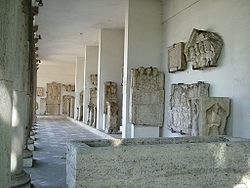This article needs additional citations for verification .(November 2023) |



A lapidarium is a place where stone (Latin: lapis ) monuments and fragments of archaeological interest are exhibited. [1]
Contents
They can include stone epigraphs; statues; architectural elements such as columns, cornices, and acroterions; bas reliefs, tombstones; and sarcophagi.
Such collections are often displayed in the outdoor courtyards of archaeology museums and history museums.
A lapidary museum could either be a lapidarium or – less often – a gem museum (e.g. the Mineral and Lapidary Museum, North Carolina).